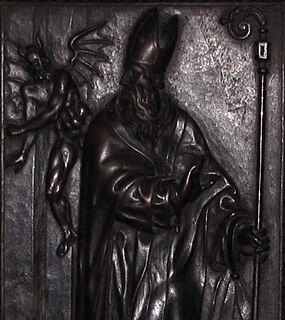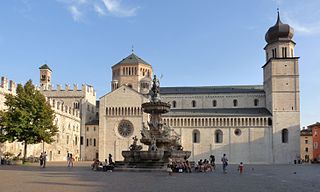Vigilius may refer to:

The Council of Trent, held between 1545 and 1563 in Trent, was the 19th ecumenical council of the Catholic Church. Prompted by the Protestant Reformation, it has been described as the embodiment of the Counter-Reformation.
Eusebius was a Roman historian, exegete and Christian polemicist.
Pope Silverius ruled the Holy See from 8 June 536 to his deposition in 537, a few months before his death. His rapid rise to prominence from a deacon to the papacy coincided with the efforts of Ostrogothic king Theodahad, who intended to install a pro-Gothic candidate just before the Gothic War. Later deposed by Byzantine general Belisarius, he was tried and sent to exile on the desolated island of Palmarola, where he starved to death in 537.
Year 555 (DLV) was a common year starting on Friday of the Julian calendar. The denomination 555 for this year has been used since the early medieval period, when the Anno Domini calendar era became the prevalent method in Europe for naming years.
Pope Vigilius was the bishop of Rome from 29 March 537 to his death. He is considered the first pope of the Byzantine papacy. Born into Roman aristocracy, Vigilius served as a deacon and papal apocrisiarius in Constantinople. He allied with Empress Theodora, who sought his help to establish Monophysitism, and was made pope after the deposition of Silverius. After he refused to sign Emperor Justinian I's edict condemning the Three Chapters, Vigilius was arrested in 545 and taken to Constantinople. He died in Sicily while returning to Rome.
Pope Pelagius I was the bishop of Rome from 556 to his death. A former apocrisiarius to Constantinople, Pelagius I was elected pope as the candidate of Emperor Justinian I, a designation not well received in the Western Church. Before his papacy, he opposed Justinian's efforts to condemn the "Three Chapters" in order to reconcile theological factions within the Church, but later adopted Justinian's position.
Sisinnius may refer to:
Saint Cyril may refer to:
The term coadjutor is a title qualifier indicating that the holder shares the office with another person, with powers equal to the other in all but formal order of precedence.
Liberatus of Carthage was an archdeacon and the author of an important history of the Nestorian and Monophysite controversies in the 5th- and 6th-century Christian Church.

Saint Juvenal is venerated as the first Bishop of Narni in Umbria. Historical details regarding Juvenal’s life are limited. A biography of Juvenal of little historical value was written after the seventh century; it states that Juvenal was born in Africa, was ordained by Pope Damasus I, was the first bishop of Narni and was buried in the Porta Superiore on the Via Flaminia on August 7, though his feast day was celebrated on May 3. This Vita does not call him a martyr but calls him a confessor. The martyrologies of Florus of Lyon and Ado describe Juvenal as a bishop and confessor rather than as a martyr.
Domnus apostolicus, contraction of dominus apostolicus, is an epithet or title historically applied to popes, especially from the 6th to the 11th centuries, and was sometimes applied to other bishops also.

Dacius or Datius was Bishop of Milan from c. 530 to 552. He is honoured as a saint in the Catholic Church.

Trento Cathedral is a Roman Catholic cathedral in Trento, northern Italy. It is the mother church of the Roman Catholic Archdiocese of Trento, and until 1802, was the seat of the Bishopric of Trent. It was built over a pre-existing 4th-century church devoted to Saint Vigilius, patron saint of the city.

Saint Cerbonius was a bishop of Populonia during the Barbarian invasions. Saint Gregory the Great praises him in Book XI of his Dialogues.

The Italian Catholic Archdiocese of Trento, in the Triveneto, is a Latin Catholic Metropolitan Archdiocese named after its see in Alpine Italy, Trento, in Trentino-Alto Adige region. On 31 May 1027, the Emperor Conrad II granted the bishops of Trent the County of Trent, making the bishops part of the German Empire, and thereby beginning the history of the prince-bishopric. As a prince-bishopric, the bishop's temporal possessions also constituted a state of the Holy Roman Empire. In 1803, the prince-bishopric was secularized and assigned to the Kingdom of Bavaria, but in 1810 Napoleon claimed it for his kingdom of Italy. On Napoleon's fall, the Tyrol became part of the Austrian Empire.

Catholic ecumenical councils include 21 councils over a period of some 1900 years, which met for the purpose of defining doctrine, reaffirming truths of the Faith, and extirpating heresy. While definitions changed throughout history, in today's Catholic understanding ecumenical councils are assemblies of patriarchs, cardinals, residing bishops, abbots, male heads of religious orders and other juridical persons, nominated by the pope. Participation is limited to these persons, who cannot delegate their voting rights. Council decisions, to be valid, are approved by the popes.

Saint Vigilius of Trent is venerated as the patron saint and first bishop of Trent. He should not be confused with the pope of the same name.

The Ostrogothic Papacy was a period from 493 to 537 where the papacy was strongly influenced by the Ostrogothic Kingdom, if the pope was not outright appointed by the Ostrogothic King. The selection and administration of popes during this period was strongly influenced by Theodoric the Great and his successors Athalaric and Theodahad. This period terminated with Justinian I's (re)conquest of Rome during the Gothic War (535–554), inaugurating the Byzantine Papacy (537-752).

The Placidia Palace was the official residence of the papal apocrisiarius, the ambassador from the pope to the patriarch of Constantinople, and the intermittent home of the pope himself when in residence at Constantinople. The apocrisiarius held "considerable influence as a conduit for both public and covert communications" between pope and Byzantine emperor.